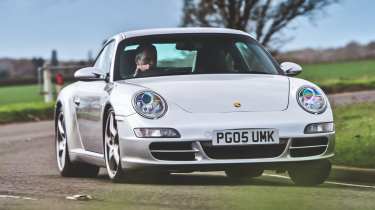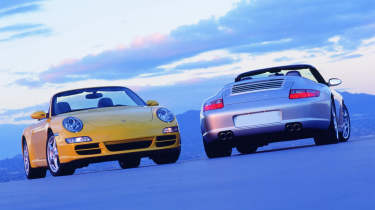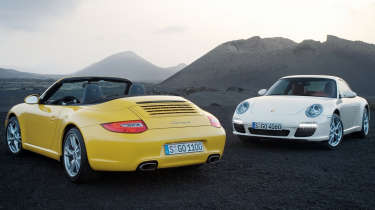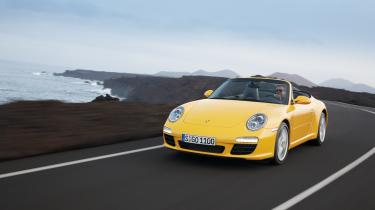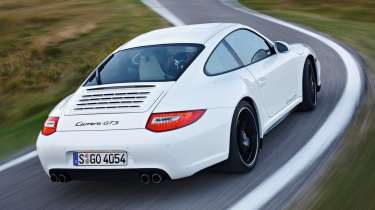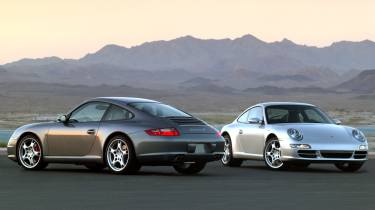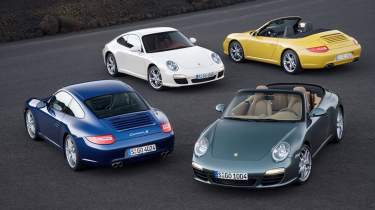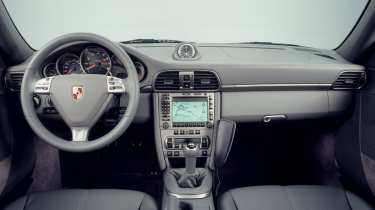Used Porsche 911 (997, 2004-2012): review, history, specs and buying guide
The 997 might be the ultimate goldilocks 911, blending modern technology, performance and reliability with a slender footprint, feelsome steering and characterful engines
On its arrival in 2004, the 997 Porsche 911 was much more of a leap forward from the 996 it replaced than the conservative visual update had anyone believe. Though the earliest water-cooled 911 has garnered affection in its third decade, it’s the 997 that was first received as a return to form for the world’s most famous sports car, so much so that it won eCoty 2004. Here’s everything you need to know about the Porsche 997 911, with excerpts from evo’s encounters with it over the years.
Faster, better balanced, higher quality inside with improved appointment, fit and finish, the 997 was arguably the first 911 to really benefit from the success of the Cayenne and the cash injection therewith. Yet for enthusiasts, it’s arguably the Goldilocks 911. It was wider and longer with a more confident grasp of the road, rounding off ‘typical 911’ dynamic shortcomings. It had a higher level of quality and reliability too. But it was also the ‘right’ size and weight, still utilised the characterful naturally-aspirated Mezger engine, was still widely available with a manual and still featured feelsome hydraulic steering.
997 Porsche 911 range explained
With the 997 generation Porsche 911, the lineup expanded enormously. The 3.8-litre Carrera S joined the 3.6-litre Carrera, as did the AWD Carrera 4S and the Carrera 4. In addition to cabriolet versions of all four, there was also the open-roof Targa 4 and Targa 4S. The fastest 997 across ground was of course the Turbo, which gained a Turbo S derivative with the 997.2 facelift.
More reviews
Group tests
In-depth reviews
Long term tests
Reviews
> Porsche 911 GT3 group test – 996 takes on 997
In addition to Porsche being able to afford a return to circular lights, the 997 also got a decent range of performance tech at the time of launch. Porsche Active Suspension Management dampers were standard on the Carrera S, as was variable ratio steering. The Sport Chrono pack was an oft-mocked option that got the buyer a stopwatch on the dash and a sport button, to optimise throttle response and open the exhaust valves. If you wanted a limited-slip diff and a more focused chassis more akin to the Carrera S, without actually getting the Carrera S, you could order standard Carrera with the Sport pack, which also lowered the car by 20mm.
For the 2008 997.2 facelift – that infamously saw the debut of direct fuel injection in a 911 – Porsche also introduced a Carrera range-topper, the GTS, available in rear and four-wheel drive. Also introduced with the facelift was the superb PDK dual-clutch transmission, taking the place of the five-speed Tiptronic automated manual.
That just about covers all the ‘conventional’ 997 911s that this page will primarily focus on. But we couldn’t not mention the specials. Over the course of the its eight-year tenure, two 997 GT3 and GT3 RS generations appeared, as did a GT2 for the 997.1 in 2007. Super special 997 variants included the 2010 911 GT2 RS for the 997.2 in 2010, the 2010 911 Sport Classic, the 2010 911 Speedster and the 2011 Porsche 911 GT3 GT3 RS 4.0.
Porsche 997 Carrera specs
Performance for the 997 generation Porsche 911 varies enormously. Get an early basic 321bhp Targa 4 with a Tiptronic transmission and 0-62mph takes 5.3sec – quick, for a hot hatch. Get a PDK-equipped 997.2 Turbo S with 523bhp, and you’ll best a Porsche Carrera GT to 62mph, in 3.3sec. Most 997 Carreras will hit 62mph in the mid to high 4sec range.
| Year | Model | Engine | Power (bhp) | Torque (lb ft) |
|---|---|---|---|---|
| 2004 | 997 Carrera | 3.6-litre flat-six | 321 | 273 |
| 2004 | 997 Carrera S | 3.8-litre flat-six | 350 | 295 |
| 2008 | 997.2 Carrera | 3.6-litre flat-six | 345 | 288 |
| 2008 | 997.2 Carrera S | 3.8-litre flat-six | 380 | 310 |
| 2010 | 997.2 Carrera GTS/’Powerkit’ | 3.8-litre flat-six | 402 | 310 |
Porsche 997 gen 2 facelift: Direct injection and PDK arrive
The LED-festooned facelift might have been subtle with the 997.2 but a lot changed underneath. Firstly, PDK twin-clutch shifting had arrived, making the ‘automatic’ a more acceptable option for keen drivers bereft of the strongest clutch legs.
Controversial however was the arrival of direct fuel injection, which while it cleaned up the flat-six’s emissions and improved its fuel efficiency, was claimed to dull some of the typical raspy flat-six 911 character. By today’s turbocharged standards of course, the 997.2’s mill is positively musical. The engine also got VarioCam Plus valvegear, with it all adding up to 345bhp for the Carrera and 380bhp for the Carrera S. The so-called ‘power kit’, bumped cars so-equipped to over 400bhp, with the mill used in the GTS and Sport Classic. This is perhaps most noticeable in terms of usable power, thanks to a wider torque curve, for a more responsive, muscular feel.
Automatics, Cabriolets, Carrera 4s and Targas: the second-tier 997s?
Given wisdom is that the very best 911s are the rear-driven ones, but it would be a mistake to discount the all-wheel-drive cars entirely. By the time the 997.2 Carrera 4S had come along, the quick-shifting PDK had replaced the Tiptronic and its electromagnetically controlled multi-plate clutch had replaced the viscous coupling of the earlier 997. Add all that together and what would previously have been seen as a bit of an apologetic option in the 911 lineup, became a fine driver’s car in its own right. Indeed, by the end of the 997’s tenure, it weighed just 55kg more than its rear-driven equivalent.
Whichever way you cut it, any all-wheel-drive 911 will be more usable, more of the time, in more of the UK’s changeable conditions, than a rear-driven car. They’re also a safer bet for less confident drivers, who want the 911 experience but with a bit of a safety net.
What about non-manual 997s? The five-speed Tiptronic transmission does age the earlier 997s to which it’s fitted and will incur a maintenance toll, too. As above, PDK modernised the automatic 911 experience markedly, being quicker on a launch and through the gears, though any naturally-aspirated 997 is far from the car for you if raw straight-line pace is what you’re after. The sports steering wheel with the optional paddles, rather than the wheel-mounted ‘buttons’, is a must too.
The Cabriolet too is often looked down upon as a second-tier 911. While the extra weight and reduced structural rigidity dulls the 911’s inimitable talents, there’s obvious alfresco value in the Cabriolet to be had with a 911 tailored for SoCal cruising. The Targa, with its odd glass roof and unique tapered side windows was arguably the black sheep of the 997 range. All were all-wheel-drive and were, owing to the wider body, sliding roof and glass high up, the most compromised 997s due to having the highest centre of gravity. Maligned at the time for being the ‘least’ 911 you can get, time as ever has softened perceptions – the 997 Targa, for instance, features a hatchback. An unprecedented concession to practicality with appreciable utility.
Porsche 997.2 Carrera GTS: peak 997?
We sort of knew it at the time but the values of them today speak volumes: the 997 GTS is a very special car. Though not prepared by the GT department as the badge might have led some to believe, the 997 GTS established a badge that stands for performance and presence, but also delicacy, subtlety and usability, at least by comparison to the Turbos and GT cars of the lineup. It was a serious thing – good for 190mph in coupe form – but it was also more versatile, available with a PDK and as a cabriolet, should you have desired.
Using the wider Carrera 4 body, the GTS got a 402bhp version of the 3.8-litre DFI flat-six, and the latest PASM, making it the most capable, most serious Carrera you could get. It also featured a huge amount of tasty goodies including a standard sports exhaust, alcantara trim inside, and 19-inch centre-locking RS Spyder wheels outside. You still had to tick the box for the sports suspension and limited-slip differential or Sport Chrono. You could also option carbon ceramic brakes.
What’s the Porsche 997 911 like to drive?
evo has driven every version of the 997 over the years. Here are excerpts from those encounters.
Porsche 997.1 Carrera S first drive, evo 070 August 2004
‘From the moment you twist the ignition key, the big-bore engine delivers a reassuringly rasping soundtrack… pleasingly deep and guttural. The major controls have a honed, knowing uniformity of weight, from steering wheel to pedals and gearshift.
‘You can sense the broad tyres shouldering their way over urban lumps and bumps, but such is the control and pliancy few sharp-edged shocks get as far as the seat cushion: impressive stuff given the extreme width and low profile of the rubber.
‘Third gear selected, I floor the throttle. With the instantaneous response of a big-capacity engine with low-inertia internals, the 997 punches forward with tremendous force, engine note hardening with effort, steam-hammer torque melding with vibrant top-end zing. No normally aspirated 911 has ever felt this muscular.
‘Resisting the temptation to fiddle with the damper settings and Sport and PSM buttons, and with confidence and speed building, grip levels are clearly huge. Switching the dampers into their firmer setting, the difference is subtle but perceptible, with more incisive turn-in and a more detailed stream of feedback flowing through the steering wheel.
‘Engaging Sport is the final piece of the puzzle, providing an electronic shot of adrenalin through the 997’s systems, sharpening its response further. The Carrera S shines a little brighter as each stage is phased-in. The bond might take a little longer to form, but the rewards are still there for the taking.’
Porsche 997.1 Carrera Sport, 2007
‘The lower, tighter stance that betrays the fitment of the £1030 sports suspension option, features re-rated steel springs and dampers, drops the ride height by 20mm and also slots a limited-slip differential between the rear wheels. To this we’d suggest you add a further £1256 for Carrera S-sized 19in ‘SportDesign’ wheels, £1216 for the sports exhaust system and a final £530 for the Sport Chrono Package Plus, which sticks a timer and a Sport button on the dash, the latter of which engages a keener throttle mapping and turns up the volume on that exhaust.
‘Adding up to just over four grand, this collection of options transforms the basic Carrera into a more satisfying and still significantly cheaper car than the £68,750 Carrera S. Indeed, we reckon it to be the ultimate all-round 997 money can buy. While models like the 997 GT3 and GT2 mean this optimised Carrera is unlikely to be all the 911 you’ll ever want, it’s undoubtedly all the 911 you’ll ever need.’
Porsche 997.2 Carrera 4 Cabriolet, 2008
‘The C4, and especially the C4S, are not without merit. All right, some of the C2’s agility and adjustability is customarily blunted by the bulkier undercarriage, but the 4wd, stiffer suspension and wider rubber that help keep the über-rapid Turbo on the island successfully endow the less potent variants with a more muscular character.
‘The viscous clutch four-wheel-drive system of the old C4 has been supplanted by the torque-apportioning electronic hardware from the Turbo, which, aided by the latest version of PASM, massages the hero factor to the point where you’d have to do something tragically inept to bin it.
‘No, you don’t feel inclined to head for the nearest race track, but it’s certainly the sort of car you’d forego sleep for to savour an early morning blast on country roads. The bodyshell is sufficiently stiff to forget about on all but the bumpiest tarmac, the handling is satisfyingly incisive and grippy but without the uncompromisingly firm ride that comes with the Sports suspension, the 3.6 direct-injection motor is marginally sweeter and more musical than the 3.8 but still properly potent, and the manual gearchange cements a sense of connectedness with the driving process PDK misses by a mile.’
Porsche 997.2 Targa 4, 2008
‘There’s oodles of clean and immediate traction, thanks to the electronic four-wheel-drive system. A by-product of that and the 44mm wider rear track, is a calmer nose – it doesn’t bob and sniff as much as the Carrera, but it also feels more numb.
‘There’s not much wrong with the Targa, but this is Porsche sleep-walking, doing what’s required to satisfy the 10 per cent of 911 buyers who crave a glass roof, but nothing more. It’s a perfect addition to the more sophisticated but less engaging new 911 range.’
Porsche 997 Carrera GTS, 2010
‘The combination of tweaked motor, wide-track chassis and fat rear tyres gives the GTS a subtly different feel compared to the narrower rear-drive Carrera S, but it’s also less full-on than a 997 GT3, so it makes a perfect everyday steer. You get tremendous confidence from the sheer grip available, but there’s still that delicious sense of balance you get from a rear-drive 911. You just have to try a bit harder to breach its limits.
‘Start to explore the middle and upper reaches of its performance and you get tremendous confidence from the sheer grip available, yet there’s still that delicious sense of balance you get from all the best rear-drive 911s. There’s plenty of feedback from the front end and huge traction from the rear, but you also get brilliant poise when you want to make fast progress, and throttle adjustability when fun is more important. Basically the harder you drive it, the better it feels.’
‘Purists may say they prefer the ultimate subtlety and delicacy of the narrow body Carrera S, but as a package, the Carrera GTS is very hard to fault. That’s why for all-round performance, value and desirability it’s our favourite non-Motorsport department 911, and a fitting finale for the 997 generation.’
Porsche 911 997 buying guide and checkpoints
If you’re thinking of buying a used 997 Porsche 911, here are our top things to consider…
Porsche 997 Engine
The two known issues with the gen-1 997 (2004-2008) flat-six are scored cylinder bores and the failure of a bearing at the end of the intermediate shaft that drives the camshafts, more commonly known as the IMS bearing. Both can result in engine failure.
Bearing failures are impossible to detect until they happen, but the good news is they are increasingly rarely seen these days. Scored bores are slightly more common, particularly with the 3.8, but there are clues in blackened tailpipes and/or a ticking noise at idle – if you encounter either, walk away. The bores can be inspected by specialists with an endoscope for peace of mind.
At this point, you should not be buying an early 997 unless it comes with recent proof of good engine health, or of remedial work done to address common issues. Sturdy service history and an as clear-as-possible MOT history are a given, and having the systems checked for over-revs and the car’s true mileage should be standard fare in the pursuit of any Porsche sports car, too.
Gen-2 cars tend not to be afflicted by the above; same goes for the Turbos and GT models, which use a different engine.
Porsche 997 transmission and drivetrain
Both the six-speed manual and the five-speed Tiptronic are robust. Clutches also last well – up to 50,000 miles. PDK transmissions are reportedly very sturdy too. Keep in mind that AWD cars could go through front tyres with more of an appetite.
Suspension, brakes and tyres
Check for corrosion on the inner disc faces – caused by lack of use and not easily spotted. Ceramic brakes are brilliant but not really necessary unless you do a lot of track work, plus they’re formidably expensive. Squeaks from the front suspension point to bushes needing replacement. All 911s deserve to wear quality rubber, so off-brand, old or poor condition tyres are your first sign that a car may not have had the most love lavished upon it.
Bodywork and interior
It’s common to respray the nose section to cover stone-chips, but if any other area has been resprayed, approach with caution – rust is not an issue with these cars yet. On convertibles, look carefully at the roof for wear and tear. Check the condition of the aircon condensers and coolant rads, which are behind the vents in the nose and can be prone to pinhole leaks. The interior is generally durable, but do check that all the electrical systems are working, particularly the PCM functions and PASM dampers.
What to pay
The 997 Porsche 911 is on the up as a revered modern classic 911. There really is no such thing as a ‘cheap’ one anymore. Cabriolets and automatics will command a lower price, as will cars with higher miles or issues to sort. A leggy Cabriolet can be had in 2024 for £16,000. Meanwhile, the very nicest, dealer-stocked 997.2s are up in the £40-£50k range.
